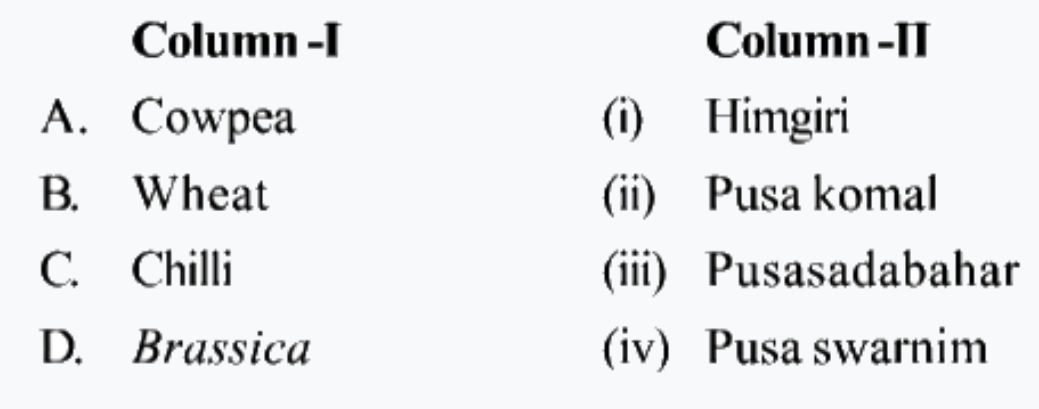Match column with column II and select the correct option from the codes given below. (There can be more than one match for column 1.)
Column IColumn II(a) Green algae(i) Gracilaria(b)Red algae(ii) Chara(c)Blue-green algae(iii) Nostoc(d) Brown algae(iv) Polysiphonia(d) Brown algae(v) Ulothrix(vi) Anabaena(vii) Sargassum(viii) Laminaria
(a)-(ii, v), (b)-(i, vi), (c)-(iii, iv), (d)-(vii, viii)
(a)-(ii, v), (b)-(i, iv), (c)-(iii, vi), (d)-(vii, viii)
(a)-(ii, vii), (b)-(i, iv), (c)-(iii, vi), (d)-(v, viii)
(a)-(ii, v), (b)-(iii, iv), (c)-(i, vi), (d)-(vii, viii)
The correct Answer is:B
To solve the question of matching the types of algae from Column I with their corresponding examples in Column II, we can follow these steps:
1. Identify Green Algae:
- Green algae are typically characterized by their green color due to chlorophyll.
- From Column II, we look for examples of green algae.
- Matches:
- (b) Green algae → (ii) Chara
- (b) Green algae → (v) Ulothrix
2. Identify Red Algae:
- Red algae are known for their reddish color due to phycoerythrin.
- From Column II, we find examples of red algae.
- Matches:
- (a) Red algae → (i) Gracilaria
- (a) Red algae → (iv) Polysiphonia
3. Identify Blue-Green Algae:
- Blue-green algae are also known as cyanobacteria and can appear blue-green due to the presence of phycocyanin.
- From Column II, we identify blue-green algae.
- Matches:
- (c) Blue-green algae → (iii) Nostoc
- (c) Blue-green algae → (vi) Anabaena
4. Identify Brown Algae:
- Brown algae are characterized by their brown color due to fucoxanthin.
- From Column II, we find examples of brown algae.
- Matches:
- (d) Brown algae → (vii) Sargassum
- (d) Brown algae → (viii) Laminaria
Final Matches:
- (a) Green algae → (ii) Chara, (v) Ulothrix
- (b) Red algae → (i) Gracilaria, (iv) Polysiphonia
- (c) Blue-green algae → (iii) Nostoc, (vi) Anabaena
- (d) Brown algae → (vii) Sargassum, (viii) Laminaria
Selected Option:
Based on the matches, the correct option is:
- A matches with (ii) and (v)
- B matches with (i) and (iv)
- C matches with (iii) and (vi)
- D matches with (vii) and (viii)
- Green algae are typically characterized by their green color due to chlorophyll.
- From Column II, we look for examples of green algae.
- Matches:
- (b) Green algae → (ii) Chara
- (b) Green algae → (v) Ulothrix
- Red algae are known for their reddish color due to phycoerythrin.
- From Column II, we find examples of red algae.
- Matches:
- (a) Red algae → (i) Gracilaria
- (a) Red algae → (iv) Polysiphonia
- Blue-green algae are also known as cyanobacteria and can appear blue-green due to the presence of phycocyanin.
- From Column II, we identify blue-green algae.
- Matches:
- (c) Blue-green algae → (iii) Nostoc
- (c) Blue-green algae → (vi) Anabaena
- Brown algae are characterized by their brown color due to fucoxanthin.
- From Column II, we find examples of brown algae.
- Matches:
- (d) Brown algae → (vii) Sargassum
- (d) Brown algae → (viii) Laminaria
- (a) Green algae → (ii) Chara, (v) Ulothrix
- (b) Red algae → (i) Gracilaria, (iv) Polysiphonia
- (c) Blue-green algae → (iii) Nostoc, (vi) Anabaena
- (d) Brown algae → (vii) Sargassum, (viii) Laminaria
Based on the matches, the correct option is:
- A matches with (ii) and (v)
- B matches with (i) and (iv)
- C matches with (iii) and (vi)
- D matches with (vii) and (viii)
Topper's Solved these Questions
- MICROORGANISMSBOOK - SCIENCE OLYMPIAD FOUNDATION CHAPTER - MICROORGANISMSEXERCISE - ACHIEVERS SECTION (HOTS)
5 Videos
- CROP PRODUCTION AND MANAGEMENTBOOK - SCIENCE OLYMPIAD FOUNDATION CHAPTER - CROP PRODUCTION AND MANAGEMENTEXERCISE - ACHIEVERS SECTION (HOTS)
5 Videos
- NSO MODEL TEST PAPER -1BOOK - SCIENCE OLYMPIAD FOUNDATION CHAPTER - NSO MODEL TEST PAPER -1EXERCISE - ACHIEVERS SECTION
2 Videos
Similar Questions
Knowledge Check
Match column I with column II and select the correct option from the codes given below.
 AA−(iv),B−(i),C−(iii),D−(ii),E−(v)BA−(iv),B−(i),C−(ii),D−(iii),E−(v)CA−(iii),B−(iv),C−(i),D−(ii),E−(iv)DA−(i),B−(ii),C−(iii),D−(iv),E−(v)
AA−(iv),B−(i),C−(iii),D−(ii),E−(v)BA−(iv),B−(i),C−(ii),D−(iii),E−(v)CA−(iii),B−(iv),C−(i),D−(ii),E−(iv)DA−(i),B−(ii),C−(iii),D−(iv),E−(v)Match columnI with column II and select the correct option from the codes given below.
 AA−(iv),B−(i),C−(iii),D−(ii),E−(v)BA−(iv),B−(i),C−(ii),D−(iii),E−(v)CA−(iii),B−(iv),C−(i),D−(ii),E−(iv)DA−(i),B−(ii),C−(iii),D−(iv),E−(v)
AA−(iv),B−(i),C−(iii),D−(ii),E−(v)BA−(iv),B−(i),C−(ii),D−(iii),E−(v)CA−(iii),B−(iv),C−(i),D−(ii),E−(iv)DA−(i),B−(ii),C−(iii),D−(iv),E−(v)Match column I with column II and select the correct option from the codes given below.
 AA−(iv),B−(i),C−(iii),D−(ii),E−(v)BA−(iv),B−(i),C−(ii),D−(iii),E−(v)CA−(iii),B−(iv),C−(i),D−(ii),E−(iv)DA−(i),B−(ii),C−(iii),D−(iv),E−(v)
AA−(iv),B−(i),C−(iii),D−(ii),E−(v)BA−(iv),B−(i),C−(ii),D−(iii),E−(v)CA−(iii),B−(iv),C−(i),D−(ii),E−(iv)DA−(i),B−(ii),C−(iii),D−(iv),E−(v)
Match Column I with column II and select the correct option from the codes given below:

View SolutionMatch column I with column II and select the correct option from the codes given below.

View SolutionMatch column I with column II and select the correct option from the codes given below .

View SolutionMatch Column I with Column II and select the correct option from the codes given below.

View SolutionMatch Column I with Column II and select the correct option from the codes given below.

View Solution


